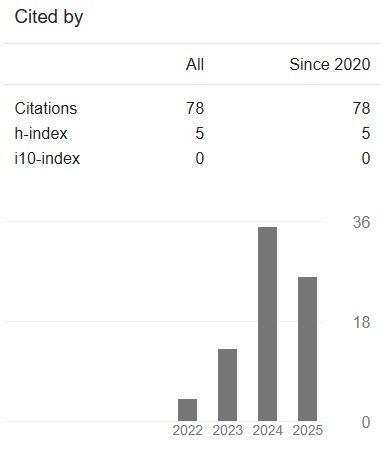Separation efficiency analysis of multiphase flow inside hydrocyclone using CFD
DOI:
https://doi.org/10.24191/jaeds.v3i1.62Keywords:
Multiphase; Hydrocyclone; CFD; Separation EfficiencyAbstract
The study of the separation phenomena inside hydrocyclone often encounters an issue related to particles being misplaced at the outputs since there is a large variety of particle densities. This research presents a numerical study of multiphase flow inside hydrocyclone to analyse the relationship between the separation efficiency of particles and the diameter of the cylindrical section to complete the separation process which greatly affect the overall performance of hydrocyclone. The performance of the hydrocyclone were evaluated using (CFD) method to simulate multiphase flow inside the hydrocyclone. In this study, the Reynolds Stress Model (RMS) is used in the model to simulate the swirling turbulent flow of gas and liquid, and the Volume of Fluid (VoF) Multiphase Model is used to simulate the interface between the liquid and the air core. The solid particle motion is then tracked using the outcomes from the simulation of particle in the The Discrete Element method (DEM) model. Pressure and velocity play important roles in the separation of particles. A centrifugal force that separates particles according to their mass is produced when the hydrocyclone's input is subjected to higher pressure. The fluid's velocity increases as it moves towards the device’s centre, causing the hydrocyclone to rotates and produces a spiral flow pattern. Higher diameter of the cylindrical section, provide higher tangential velocity of particles and their centrifugal forces, resulting in great collection efficiency. In this paper, it has been demonstrated numerically that the performance of hydrocyclone is significantly influenced by the different diameter of the cylindrical section. As of the simulation analysis, increasing the diameter of the cylindrical section has increased the separation efficiency from 34.4% to 44.3% for particle size of 5 μm respectively. Based on the pressure, velocity and streamlines distribution profiles obtained, the results revealed that the tangential velocity contributes largely to the centrifugal forces, resulting in a substantial collection. The increase in diameter increases the residence time of particles inside the hydrocyclone making the swirl rotation of particles more frequent. Thus, it increases the effect of clarity separation and boosts separation accuracy and efficiency.
Downloads
References
Akhbarifar S., Shirvani M., Zahedi S., Zahiri M.R., Shamsaii Y.,” Improving Cyclone Efficiency by Recycle and Jet Impingement Streams,” Iranian Journal of Chemistry and Chemical Engineering (IJCCE), 30(2): 119-124, 2011.
Sonali Swain, Swati Mohanty, “A 3-dimensional Eulerian–Eulerian CFD simulation of a hydrocyclone,” Applied Mathematical Modelling 37(5), 2921-2932, 2013.
Vega-Garcia, D., Brito-Parada, P. R., & Cilliers, J. J., “Optimising small hydrocyclone design using 3D printing and CFD simulations,” Chemical Engineering Journal, 350, 653–659, 2018.
Izadi, M., Makvand, A. M., Assareh, E., & Parvaz, F., “Optimizing the design and performance of solid–liquid separators,” International Journal of Thermofluids 100033, 5–6, 2020.
Tongsir, S., “The Simulation of Hydrocyclone Network for Separating Yeast and Calcium in Ethanol Production, in Chemical and Process Engineering”, King Mongkut’s University of Technology North Bangkok, 2007.
Rudolf, P., “Simulation of multiphase flow in hydrocyclone,” EPJ Web of Conferences, 45, 2013.
Brennan, M.S., Narasimha, M., Holtham, P.N, “Multiphase modelling of hydrocyclones–prediction of cut-size,” Miner. Eng. 20, 395–406, 2007.
Wang, B., Yu, A.B., “Numerical study of particle–fluid flow in hydrocycloneswith different body dimensions,” Miner. Eng. 19 (10), 1022–1033, 2006.
Mousavian, S.M., Najafi, A.F., “Numerical simulations of gas–liquid–solid flowsin a hydrocyclone separator,” Archive of Applied Mechanics 79 (5), 395–409, 2009.
Narasimha, M., Brennan, M., Holtham, P.N., “A review of CFD modelling for performance predicitons of hydrocyclone.,” Engineering Applications of Computational Fluid Mechanics 1 (2), 109–125, 2007.
Farah Miza, “Computational Fluid Dynamics Study On Vortixx Compact Flotation Unit,” Faculty of Mechanical Engineering Universiti Teknologi MARA (UiTM). [Accessed Feb 31, 2022]
Khairy Elsayed , Chris Lacor, “Optimization of the cyclone separator geometry for minimum pressure drop using mathematical models and CFD simulations,” Chemical Engineering Science, 65(22),:6048-6058, 2010.
Zhou, Cuihong & Wang, Shihan & Yang, Changshun & Xu, Ling., “Study on Particle-Size Control of Hydrocyclone for Slurry Recycles,” IOP Conference Series: Earth and Environmental Science, 2018.
Zhao, Z., Wang, H., Xie, C. et al, “Hydrocyclone separation performance influenced by feeding solid concentration and correcting separation size,” Heat Mass Transfer 57, 63–76, 2021.
Nunes S, Magalhães H, Neto S et al., “Impact of permeable membrane on the hydrocyclone separation performance for oily water treatment,” Membranes 10, 350, 2020.
Downloads
Published
How to Cite
Issue
Section
License
Copyright (c) 2023 MOHAMAD MAZWAN MAHAT, HAZRAN HUSAIN, NOR SAFWAN MOHMAD

This work is licensed under a Creative Commons Attribution 4.0 International License.









